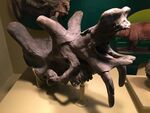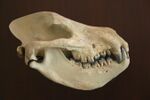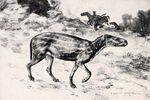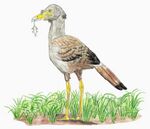Earth:Washakie Formation
From HandWiki
| Washakie Formation Stratigraphic range: Lutetian (Bridgerian-Uintan) ~48–42 Ma | |
|---|---|
| Type | Formation |
| Sub-units | Adobe Town & Kinney Rim members |
| Lithology | |
| Primary | Sandstone |
| Location | |
| Coordinates | [ ⚑ ] : 41°42′N 109°00′W / 41.7°N 109.0°W |
| Paleocoordinates | [ ⚑ ] 45°36′N 95°06′W / 45.6°N 95.1°W |
| Region | Colorado & Wyoming |
| Country | |
| Extent | Sand Wash & Washakie Basins |
| Lua error in Module:Location_map/multi at line 27: Unable to find the specified location map definition: "Module:Location map/data/Wyoming" does not exist. | |
The Washakie Formation is a geologic formation in northern Colorado and southern Wyoming. It preserves many mammal, bird, reptile and other fossils dating back to the Lutetian stage of the Eocene within the Paleogene period. The sediments fall in the Bridgerian and Uintan stages of the NALMA classification.[1]
Fossil content
The Washakie Formation has provided many fossil mammals, turtles and other reptiles, birds and other fossils.[1]
The artiodactyl Heliosus apophis was described from the formation by Burger and Jolley,[2] and the rodents Pareumys flynni, Pauromys turnbulli and Thisbemys intermedius by Korth in 2020.[3][4]
Mammals
| Cimolestans | |||||
|---|---|---|---|---|---|
| Genus | Species | Presence | Material | Notes | Images |
| Stylinodon | S. mirus | Lower part of the Adobe Town Member.[5] | 6 specimens.[5] | A taeniodont. | |
| Ferae | |||||
|---|---|---|---|---|---|
| Genus | Species | Presence | Material | Notes | Images |
| Carnivoraformes gen. indet. | species A | Adobe Town Member.[6] | Tooth fragments.[6] | A carnivoraform. | |
| species B | Adobe Town Member.[6] | Teeth.[6] | A carnivoraform. | ||
| Harpalodon | H. sylvestris | Adobe Town Member.[6] | A carnivoraform. | ||
| Hyaenodontidae | Hyaenodontidae gen. indet. | 2 partial teeth.[6] | A hyaenodont. | ||
| Limnocyon | L. potens | Adobe Town Member.[6] | Partial skeleton.[6] | A hyaenodont. | |
| L. verus | Adobe Town Member.[6] | A hyaenodont. | |||
| Lycarion | L. medius | Adobe Town Member.[6] | Cranium, dentary and right humerus.[6] | A carnivoraform. | |
| Machaeroidinae | Machaeroidinae gen. indet. | Posterior fragment of a right molar.[6] | An oxyaenid. | ||
| Neovulpavus | N. mccarrolli | Adobe Town Member.[6] | A carnivoraform. | ||
| N. washakius | Adobe Town Member.[6] | A carnivoraform. | |||
| Oodectes | O. proximus | Adobe Town Member.[6] | Labial fragment of right molar.[6] | A miacid. | |
| O. pugnax | Adobe Town Member.[6] | Partial left dentary.[6] | A miacid. | ||
| Patriofelis | P. ferox | Adobe Town Member.[6] | An oxyaenid. | ||
| Sinopa | S. lania | Adobe Town Member.[6] | A hyaenodont. | ||
| S. major | Adobe Town Member.[6] | A hyaenodont. | |||
| S. cf. S. minor | Adobe Town Member.[6] | "FMNH PM 56405, right m1 with broken paraconid".[6] | A hyaenodont. | ||
| S. species A | Adobe Town Member.[6] | Left maxillary fragment.[6] | A hyaenodont. | ||
| Thinocyon | T. cf. T. medius | Adobe Town Member.[6] | Teeth.[6] | A hyaenodont. | |
| T. velox | Adobe Town Member.[6] | A hyaenodont. | |||
| Tritemnodon | T. sp. | Dentary fragments, fragments of vertebra and ulna.[6] | A hyaenodont. | ||
| Uintacyon | U. jugulans | Adobe Town Member.[6] | Left dentary fragment and right molar.[6] | A miacid. | |
| Viverravus | V. gracilis | Adobe Town Member.[6] | Dentaries and teeth.[6] | A viverravid. | |
| V. minutus | Adobe Town Member.[6] | Right dentary fragment.[6] | A viverravid. | ||
| V. sp. indet. | Right dentary fragment.[6] | A viverravid. | |||
| Rodents | |||||
|---|---|---|---|---|---|
| Genus | Species | Presence | Material | Notes | Images |
| Mattimys | M. sp. | Lower Adobe Town Member.[3] | "FMNH PM 56559, right dentary fragment with m1."[3] | An ischyromyid. | |
| Metaparamys | M. compressidens | Middle and upper Adobe Town Member.[3] | Skull fragment and dentaries.[3] | An ischyromyid. | |
| Mysops | M. sp. | Adobe Town Member.[3] | "FMNH PM 55377, right m1 or m2."[3] | A cylindrodontid. | |
| Pareumys | P. flynni | Lower, middle and upper Adobe Town Member.[3] | Dentaries and teeth.[3] | A cylindrodontid. | |
| Pauromys | P. turnbulli | Middle Adobe Town Member.[3] | Dentaries.[3] | A sciuravid. | |
| Perasciuravus | P. mcintoshi | Lower and possibly middle Adobe Town Member.[7] | A sciuravid. | ||
| Protoptychus | P. hatcheri | Middle Adobe Town Member.[3][8] | |||
| Quadratomus | Q. grandis | Lower Adobe Town Member.[3] | "FMNH PM 55166, left M1 or M2; FMNH PM 55348, associated right p4 and m1."[3] | An ischyromyid. | |
| Thisbemys | T. intermedius | [4] | An ischyromyid. | ||
| T. cf. T. uintensis | [4] | An ischyromyid. | |||
| Tillomys | T. senex | Lower and middle Adobe Town Member.[3] | Left dentary and teeth.[3] | A sciuravid. | |
| Uintaparamys | U. bridgerensis | Lower and middle Adobe Town Member.[3] | Left and right dentaries.[3] | An ischyromyid. | |
| Ungulates | |||||
|---|---|---|---|---|---|
| Genus | Species | Presence | Material | Notes | Images |
| Amynodon | A. advenus | Middle unit of the Adobe Town Member.[9] | An amynodontid. | ||
| Dilophodon | D. minusculus | Middle unit of the Adobe Town Member.[9] | A helaletid. | ||
| Dolichorhinus | D. sp. | Middle unit of the Adobe Town Member.[9] | A brontothere. | ||
| Eobasileus | E. cornutus | Adobe Town Member.[10] | A dinoceratan. | ||
| Eomoropus | E. amarorum | Middle unit of the Adobe Town Member.[9] | An eomoropid. | ||
| Epihippus | E. gracilis | Upper unit of the Adobe Town Member.[9] | An equid. | ||
| cf. Forstercooperia | cf. F. minuta | Middle unit of the Adobe Town Member.[9] | A paracerathere, now reassigned to the genus Pappaceras. | ||
| Harpagolestes | H. immanis | Adobe Town Member.[6] | A mesonychid. | ||
| H. sp. indet. | Mandibular fragments.[6] | A mesonychid. | |||
| Helaletes | H. nanus | Kinney Rim Member.[9] | A helaletid. | ||
| Heliosus | H. apophis | Lower Adobe Town Member.[11] | Dentary and associated humerus.[11] | A helohyid. | |
| Hyrachyus | H. eximius | Kinney Rim Member and lower unit of the Adobe Town Member.[9] | A rhinoceratoid. | ||
| H. modestus | Kinney Rim Member and lower unit of the Adobe Town Member.[9] | A rhinoceratoid. | |||
| Isectolophus | I. latidens | Lower unit of the Adobe Town Member.[9] | An isectolophid. | ||
| Mesatirhinus | M. sp. | Kinney Rim Member and lower unit of the Adobe Town Member.[9][12] | Over 20 partial skeletons.[12] | A brontothere. | |
| Mesonychia? | Mesonychia? gen. indet. | Teeth.[6] | A mesonychian. | ||
| Metarhinus | M. sp. | Middle unit of the Adobe Town Member.[9] | A brontothere. | ||
| Orohippus | O. sp. | [9] | An equid. | ||
| Pappaceras | P. minuta | Middle unit of the Adobe Town Member.[9] | A paracerathere. | ||
| Simidectes | aff. S.? | Left molar.[6] | A mesonychian. | ||
| Synoplotherium | S. lanius | Adobe Town Member.[6] | A mesonychid. | ||
| S. sp. indet. | [6] | A mesonychid. | |||
| Telmatherium | T. sp. | Lower unit of the Adobe Town Member.[9] | A brontothere. | ||
| Triplopus | T. cubitalis | Middle unit of the Adobe Town Member.[9] | A hyracodontid. | ||
| T. implicatus | [9] | A hyracodontid. | |||
| Uintatherium | U. anceps | Adobe Town Member.[10] | A dinoceratan. | ||
Reptiles
| Birds | |||||
|---|---|---|---|---|---|
| Genus | Species | Presence | Material | Notes | Images |
| Bathornis | B. grallator | "Sand Wash Basin, Wyoming, locality 196".[13] | Partial skeleton (CM 9377).[13] | A bathornithid. | |
| Neocathartes | N. grallator | "Sand Wash Basin, Wyoming, locality 196".[13] | Considered a junior synonym of Bathornis grallator. | ||
| Testudines | |||||
|---|---|---|---|---|---|
| Genus | Species | Presence | Material | Notes | Images |
| Anosteira | A. pulchra | Adobe Town Member (Sweetwater County, Wyoming).[14] | FMNH PR966, a near-complete cranium.[14] | A carettochelyid turtle. | |
See also
- List of fossiliferous stratigraphic units in Wyoming
- Paleontology in Wyoming
- Bridger Formation
- Green River Formation
- Uinta Formation
- Wasatch Formation
References
- ↑ 1.0 1.1 Washakie Formation at Fossilworks.org
- ↑ Burger & Jolley, 2020, p.178
- ↑ 3.00 3.01 3.02 3.03 3.04 3.05 3.06 3.07 3.08 3.09 3.10 3.11 3.12 3.13 3.14 3.15 3.16 3.17 Korth, William W. (2020-05-14). "New material of fossil rodents (Mammalia) from the Eocene (Bridgerian-Uintan) Washakie Formation, southcentral Wyoming". Proceedings of the Biological Society of Washington 133 (1): 18. doi:10.2988/19-00011. ISSN 0006-324X.
- ↑ 4.0 4.1 4.2 Korth, William W. (October 2020). "The Eocene ischyromyid rodent Thisbemys from the Washakie Formation, Wyoming (early Eocene, late Bridgerian) with comments on the systematics of the genus". Journal of Paleontology 94 (6): 1180–1190. doi:10.1017/jpa.2020.37. ISSN 0022-3360. https://bioone.org/journals/journal-of-paleontology/volume-94/issue-6/jpa.2020.37/The-Eocene-ischyromyid-rodent-Thisbemys-from-the-Washakie-Formation-Wyoming/10.1017/jpa.2020.37.full.
- ↑ 5.0 5.1 Turnbull, William D. (December 2004). [303:TOTWFS2.0.CO;2.full "Taeniodonta of the Washakie Formation, Southwestern Wyoming"]. Bulletin of Carnegie Museum of Natural History 2004 (36): 303–333. doi:10.2992/0145-9058(2004)36[303:TOTWFS2.0.CO;2]. ISSN 0145-9058. https://bioone.org/journals/bulletin-of-carnegie-museum-of-natural-history/volume-2004/issue-36/0145-9058_2004_36_303_TOTWFS_2.0.CO_2/TAENIODONTA-OF-THE-WASHAKIE-FORMATION-SOUTHWESTERN-WYOMING/10.2992/0145-9058(2004)36[303:TOTWFS]2.0.CO;2.full.
- ↑ 6.00 6.01 6.02 6.03 6.04 6.05 6.06 6.07 6.08 6.09 6.10 6.11 6.12 6.13 6.14 6.15 6.16 6.17 6.18 6.19 6.20 6.21 6.22 6.23 6.24 6.25 6.26 6.27 6.28 6.29 6.30 6.31 6.32 6.33 6.34 6.35 6.36 6.37 6.38 6.39 6.40 6.41 Tomiya, Susumu; Zack, Shawn P.; Spaulding, Michelle; Flynn, John J. (March 2021). "Carnivorous mammals from the middle Eocene Washakie Formation, Wyoming, USA, and their diversity trajectory in a post-warming world" (in en). Journal of Paleontology 95 (S82): 1–115. doi:10.1017/jpa.2020.74. ISSN 0022-3360.
- ↑ Korth, William W. (2020-07-31). "A New Sciuravid Rodent (Mammalia) from the Early Eocene (Bridgerian) and the Sciuravid-Eomyid Transition". Annals of Carnegie Museum 86 (2): 197–205. doi:10.2992/007.086.0204. https://www.researchgate.net/publication/346137443.
- ↑ Turnbull, William D. (1991). Protoptychus hatcheri Scott, 1895: the mammalian faunas of the Washakie Formation, Eocene age, of southern Wyoming. University of Illinois Urbana-Champaign. Chicago, Ill. : Field Museum of Natural History. http://archive.org/details/protoptychushatc21turn.
- ↑ 9.00 9.01 9.02 9.03 9.04 9.05 9.06 9.07 9.08 9.09 9.10 9.11 9.12 9.13 9.14 9.15 9.16 McCarroll, Steven M.; Flynn, John J.; Turnbull, William D. (1996). The mammalian faunas of the Washakie Formation, Eocene age, of southern Wyoming. Chicago, Ill: Field Museum of Natural History. https://www.biodiversitylibrary.org/bibliography/2705.
- ↑ 10.0 10.1 Turnbull, W. (1978). "The Mammalian faunas of the Washakie Formation, Eocene Age, of Southern Wyoming: Part I: Introduction: The geology, history, and setting". Fieldiana Geology. doi:10.5962/BHL.TITLE.5350.
- ↑ 11.0 11.1 Burger, Benjamin John; Jolley, Lea Ann (March 2020). "A New Large Body Helohyid (Artiodactyla) from the Bridgerian Middle Eocene Washakie Formation Of Southern Wyoming". Paludicola 12 (4): 175–184. https://www.researchgate.net/publication/340901987.
- ↑ 12.0 12.1 Turnbull, William D.; Martill, David M. (1988-02-15). "Taphonomy and preservation of a monospecific titanothere assemblage from the Washakie formation (Late Eocene), southern Wyoming. An ecological accident in the fossil record" (in en). Palaeogeography, Palaeoclimatology, Palaeoecology. Ecological and Evolutionary Implications of Taphonomic Processes 63 (1): 91–108. doi:10.1016/0031-0182(88)90092-2. ISSN 0031-0182. Bibcode: 1988PPP....63...91T. https://dx.doi.org/10.1016/0031-0182%2888%2990092-2.
- ↑ 13.0 13.1 13.2 Mayr, Gerald (March 2016). "Osteology and phylogenetic affinities of the middle Eocene North American Bathornis grallator—one of the best represented, albeit least known Paleogene cariamiform birds (seriemas and allies)" (in en). Journal of Paleontology 90 (2): 357–374. doi:10.1017/jpa.2016.45. ISSN 0022-3360. https://www.cambridge.org/core/journals/journal-of-paleontology/article/abs/osteology-and-phylogenetic-affinities-of-the-middle-eocene-north-american-bathornis-grallatorone-of-the-best-represented-albeit-least-known-paleogene-cariamiform-birds-seriemas-and-allies/8219C0651F4A5828C644CE21E3030E6D.
- ↑ 14.0 14.1 Joyce, Walter G.; Volpato, Virginie S.; Rollot, Yann (2018-12-13). "The skull of the carettochelyid turtle Anosteira pulchra from the Eocene (Uintan) of Wyoming and the carotid canal system of carettochelyid turtles". Fossil Record 21 (2): 301–310. doi:10.5194/fr-21-301-2018. ISSN 2193-0074. https://www.researchgate.net/publication/329626030.
Bibliography
- Burger, B.J.; Jolley, L.A. (2020). "A new large body helohyid (Artiodactyla) from the Bridgerian Middle Eocene Washakie Formation of southern Wyoming". Paludicola 12 (4): 175–184. https://www.researchgate.net/publication/340901987. Retrieved 2020-06-28.
- Korth, William W (2020a). "New material of fossil rodents (Mammalia) from the Eocene (Bridgerian-Uintan) Washakie Formation, southcentral Wyoming". Proceedings of the Biological Society of Washington 133 (1): 18–34. doi:10.2988/19-00011.
- Korth, William W (2020b). "The Eocene ischyromyid rodent Thisbemys from the Washakie Formation, Wyoming (early Eocene, late Bridgerian) with comments on the systematics of the genus". Journal of Paleontology 94 (6): x. doi:10.1017/jpa.2020.37.
Further reading
- W. G. Joyce, V. S. Volpato, and Y. Rollot. 2018. The skull of the carettochelyid turtle Anosteira pulchra from the Eocene (Uintan) of Wyoming and the carotid canal system of carettochelyid turtles. Fossil Record 21:301-310
- N. Vitek. 2011. Insights into the Taxonomy and Systematics of North American Eocene Soft-Shelled Turtles from a Well-Preserved Specimen. Bulletin of the Peabody Museum of Natural History 52(2):189-208
- S. M. McCarroll, J. J. Flynn, and W. D. Turnbull. 1996. Biostratigraphy and magnetostratigraphy of the Bridgerian-Uintan Washakie Formation, Washakie Basin, Wyoming. In D. R. Prothero and R. J. Emry (eds.), The Terrestrial Eocene-Oligocene Transition in North America 25-39
- R. K. Stucky, D. R. Prothero, W. G. Lohr and J. R. Snyder. 1996. Magnetic stratigraphy, sedimentology, and mammalian faunas of the early Uintan Washakie Formation, Sand Wash Basin, northwestern Colorado. In D. R. Prothero and R. J. Emry (eds.), The Terrestrial Eocene-Oligocene Transition in North America 40-51
- S. M. McCarroll, J. J. Flynn, and W. D. Turnbull. 1996. The Mammalian Faunas of the Washakie Formation, Eocene Age, of Southern Wyoming. Part III. The Perissodactyls. Fieldiana, Geology 33:1-38
- A. Wetmore. 1944. A new terrestrial vulture from the Upper Eocene deposits of Wyoming. Annals of Carnegie Museum 30:57-69
- R. Zangerl. 1944. Brachyuranochampsa eversolei, gen. et sp. nov., a new crocodilian from the Washakie beds of Wyoming. Annals of Carnegie Museum 30:77-84
- O. P. Hay. 1908. The fossil turtles of North America. Carnegie Institution of Washington Publication 75:1-568
 |


















